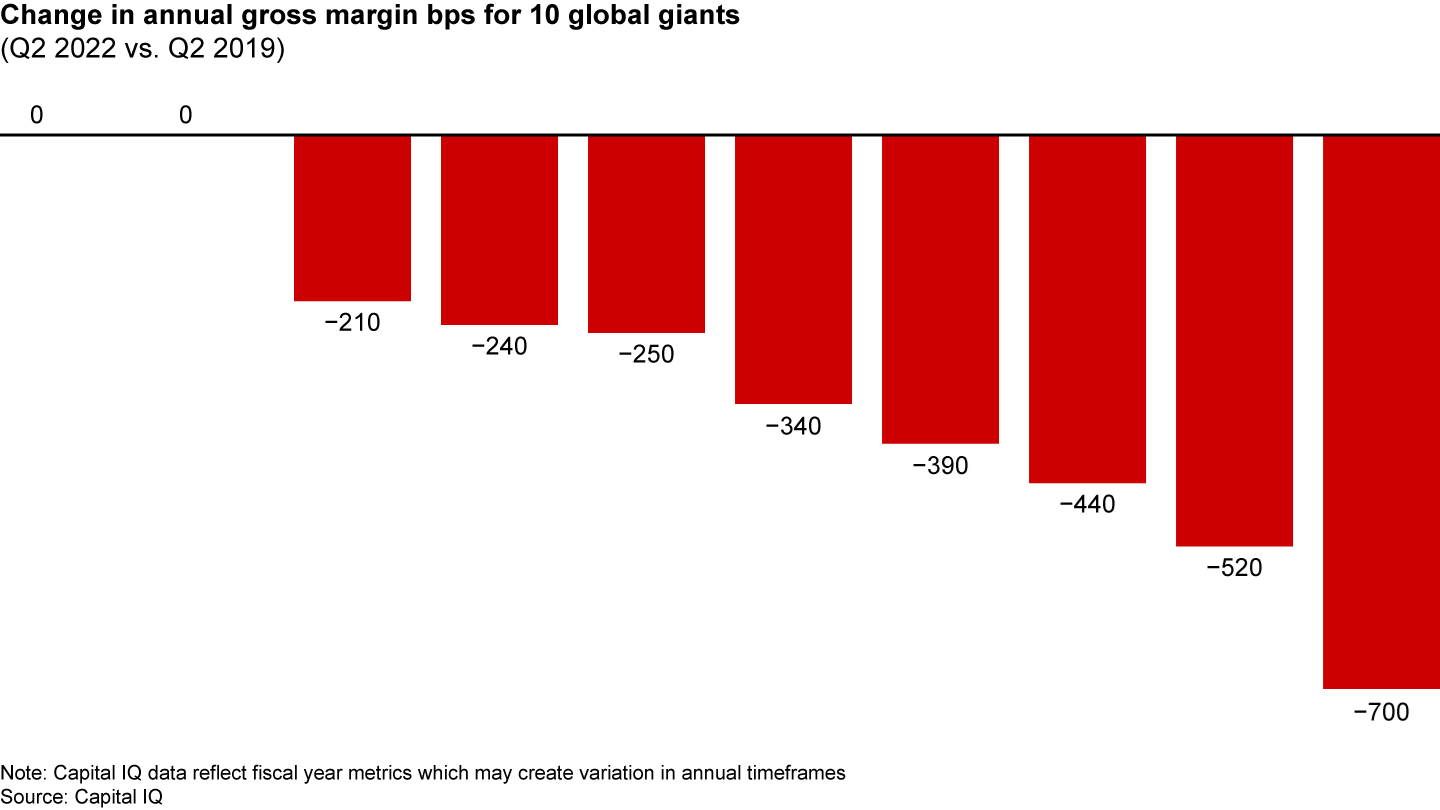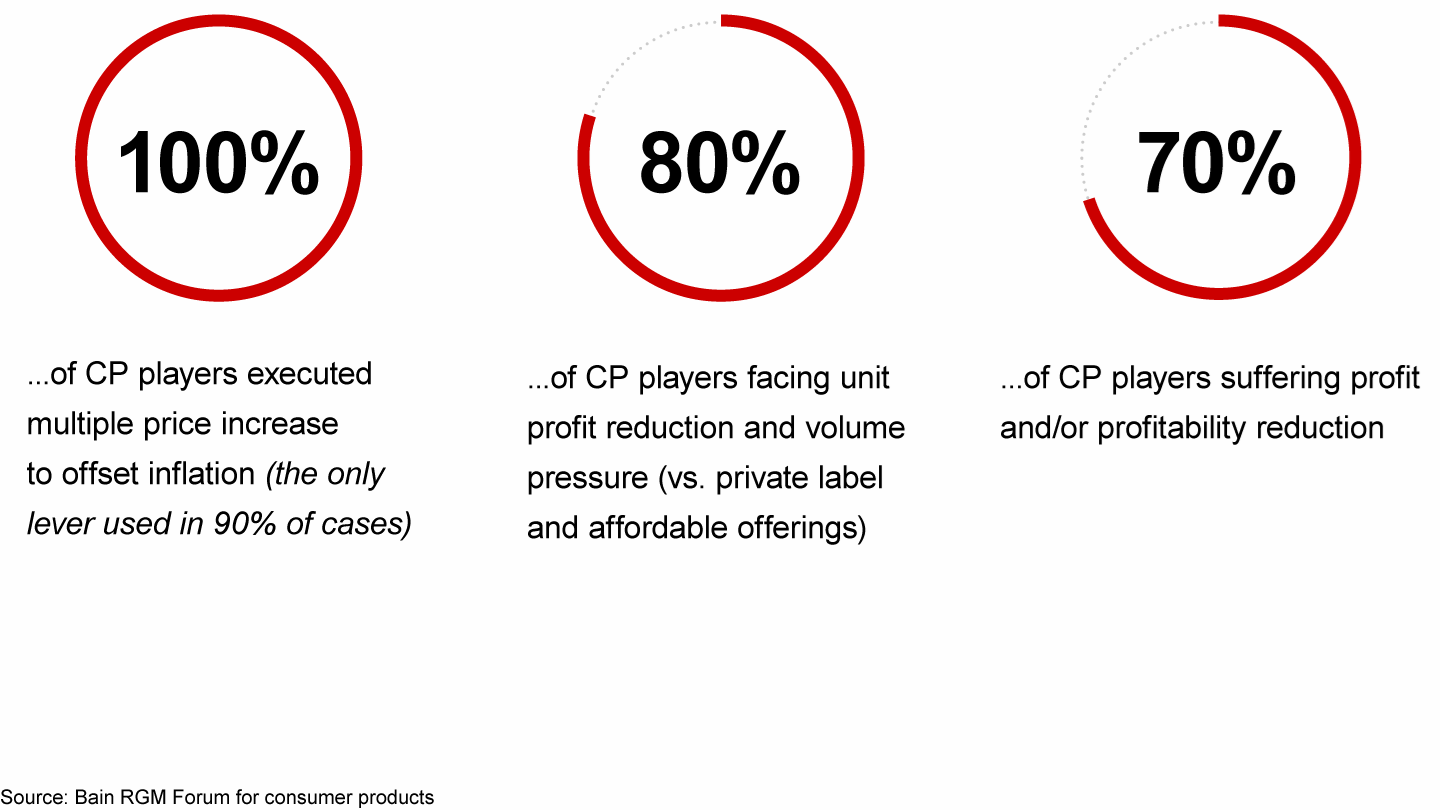Article

A series of macroeconomic disruptions have triggered inflation and widespread predictions of a recession. Even if one does not come to pass, in the medium term a combination of supply and demand factors suggests that structural inflation will continue to pose a challenge.
How much of a challenge? As Fitch Ratings recently noted, “The post-pandemic recovery in EMEA fast-moving consumer goods (FMCG) companies’ profitability has been affected by significant cost increases and supply chain disruptions that are likely to persist in 2023. Furthermore, consumer spending patterns could see adverse changes in the near term, challenging companies’ ability to pass on unprecedented cost increases.”
These pressures are having negative effects along the entire value chain, from manufacturers to consumers, with consumer packaged goods companies perhaps taking the largest hit. Despite increasing prices several times—an approach that is not sustainable—CPGs have seen profits erode (see Figure 1). Many CEOs say their teams are struggling to find better responses. In an effort to maintain traffic, retailers have not passed on full prices to consumers, yet consumers are feeling the pinch nonetheless, and signs of consumption fatigue are evident. Many shoppers are responding with a flight to value, creating opportunities for private labels and discount retailers.
Gross margins are under unprecedented pressure


Amid these challenges, now is the ideal time for revenue growth management (RGM) leaders to step up and guide their companies to better performance. Companies have attempted to implement RGM programs for some time (see Figure 2), but often struggle to achieve the expected benefits. Our holistic approach has proven effective because it is informed by five core principles.
Performance suffers despite multiple revenue growth management programs


1. Seize the leadership moment
This is a major inflection point for the CPG industry, one in which RGM leaders should play an active role in defending the joint profit pool. CPGs must become clearer on what they are trying to solve for, and in what time horizon, which requires a balance of short- and long-term objectives. Those efforts demand a new set of KPIs, linked to well-defined objectives and tailored to categories and channels.
2. Make bold moves
CPGs should think big, taking a close look at every component of RGM. They should be selective about where they focus their attention but make bold moves on the actions they deem most promising. The immediate focus will be on stopping value leakage and rethinking many aspects of your strategy through a zero-based redesign focused on RGM levers beyond price. This approach enables you to:
- Rethink price pack architecture to balance the need for affordability with profit and category expansion (e.g., satisfy emerging needs and occasions with smaller packs).
- Zero-base your promotions strategy and its mechanics to maximize incremental household penetration and reshape category economics for manufacturers, trade, and consumers.
- Double down on essential, value accretive mix focused on new “hero” SKUs with high store productivity (profit pool velocity) and increased consumer relevance (incremental penetration). Make sure to develop profitable solutions to exploit the tailwind channel and customer shifts that are happening.
3. Transform the organization
Beyond those targeted, tactical moves, companies can respond to today’s turbulent environment by developing new capabilities and supporting organizational behaviors that ensure your teams execute these bold moves effectively. Leaders should encourage stronger collaboration across functions, embrace dynamic scenario planning, and establish incentives linked to relevant KPIs. In short, success depends in large measure on a holistic approach and an unprecedented level of team effort.
4. Elevate the retailer-manufacturer relationship
With inflation adding pressure to retailer-manufacturer relations and increased consolidation giving retailers more bargaining power, it’s critical to foster a much stronger level of collaboration with retailers. CPGs should focus on creating joint value with retailers (and consumers), while at the same time recognizing when a bolder posture may be required to protect a category’s value pool.
5. Focus on your most strategic markets—and Europe
We suggest that CPGs pay particular attention to Europe as they embark on these transformational RGM efforts, as that region presents a more challenging trade environment characterized by tougher negotiations, competition from discounters, and continuing private-label growth, causing a faster erosion of profit pools.
No one would argue that RGM is simple, but when it’s effectively implemented it provides a sustained competitive advantage that can help CPGs navigate even the choppiest waters.